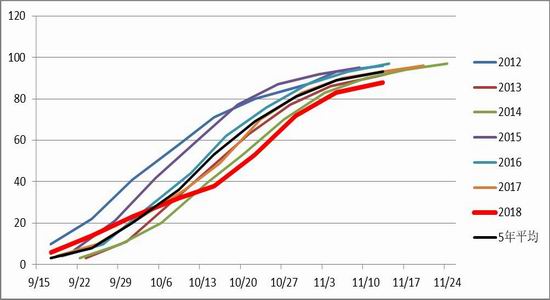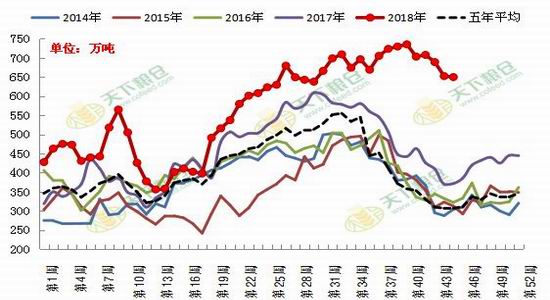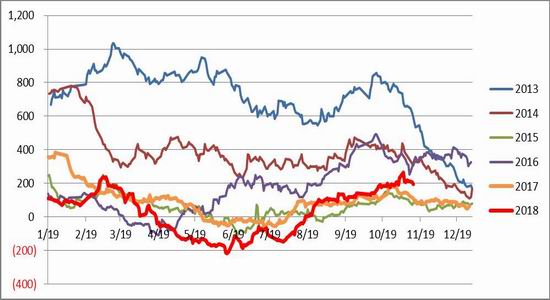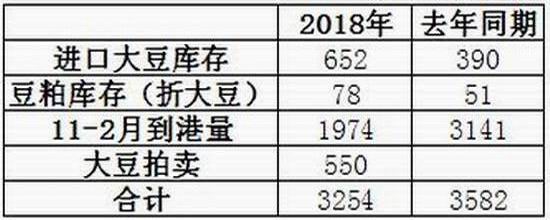Trend view:
At present, the harvest of Meidou has come to an end. After the release of the harvest pressure, Meidou has little room for substantial adjustment in the later period. On the domestic side, with the domestic imports in November soybean The arrival in Hong Kong has gradually slowed down, and the import of soybeans and Soybean meal It may enter the stage of inventory reduction. In the later stage, under the situation of gradually tightening supply of imported soybeans, it is not ruled out that there is a supply gap of soybeans before the listing of South American soybeans, and soybean meal may become stronger again. At the end of the month, the market's expectation of the Sino US trade war before the G20 Xi Jinping Special Session eased, causing a sharp correction in soybean meal. However, from the expected easing to the implementation of soybean tariff related policies, it could not be achieved overnight. Before the Xi Jinping Special Session, soybean meal gave back the premium of the trade war, and the low investment value of soybean meal began to appear. In terms of operation, soybean meal could be distributed at a low price.
Analysis of influencing factors:
1、 The harvest of American beans in 2018/19 came to an end, and the harvest pressure was reduced
Figure 1: Summary of harvest progress of American beans (unit:%)
Data source: USDA, Shanghai Mid term
The abnormal performance of excessive rainfall in October has obviously hindered the harvest of American beans. As of November 13, the harvest rate of American beans in 2018/19 was 88%, slower than the five-year average of 93%. The harvest delay also led to the loss of soybean yield. In November, the USDA supply and demand report reduced the yield of newly planted American beans to 52.1 pu/acre. At present, the harvest of American soybeans is nearing the end, and South American soybeans have been basically sold out. Before the launch of South American soybeans, American soybeans are difficult to decline significantly.
2、 The arrival of imported soybeans in Hong Kong slowed down, and the inflection point of stocks is expected to emerge
Figure 2: Domestic coastal soybean carry over inventory (unit: 10000 tons)
Data source: Tianxia Granary, Shanghai Mid term
Figure 3: Domestic coastal soybean meal carry forward inventory (unit: 10000 tons)
Data source: Tianxia Granary, Shanghai Mid term
Figure 4: Average spot price basis of soybean meal (unit: yuan/ton)
Data source: USDA, Shanghai Mid term
At present, domestic stocks of imported soybeans and soybean meal are at a high level compared with previous years, and short-term supply is not short. However, since the arrival of imported soybeans in Hong Kong has gradually decreased since November, the stocks of imported soybeans and soybean meal may be reduced. On the consumer side, with the soybean meal entering the peak consumption season in December, the consumer side expects a seasonal recovery. From the historical trend of soybean meal, the probability of soybean meal strengthening in December is high. Under the expectation of the inflection point of the inventory, the trend of spot and basis of soybean meal was stronger, which also played a supporting role for soybean meal. As of November 14, the average spot price of soybean meal was 207 yuan/ton compared with M1901, an increase of 112 yuan/ton compared with the same period last year.
Table 1: Estimated soybean supply from November 2018 to February 2019 (unit: 10000 tons)
Data source: Tianxia Granary, Shanghai Mid term
As Brazil's old crops are basically sold out, without purchasing American soybeans, whether there is a gap in domestic soybean supply becomes the focus of the market before a large number of Brazilian soybeans are launched in February 2018/19. According to the estimate of Tianxia Granary Network, China's soybean imports to Hong Kong in November/December/January/February were 574/600/5/3 million tons, a total decrease of 11.67 million tons compared with 867/955/848/564 million tons in the same period last year. In addition, the market news said that the junior high school grain storage plan in 19 years targeted the sales of 5-6 million tons of temporarily stored soybeans to some oil plants. If calculated according to the dumping and storage situation, the gap before February was about 3.3 million tons, and the uncertainty of domestic soybean supply in the later period will support soybean meal.
3、 Analysis on the Trend of American Soybean and Soybean Meal after the Special Session
At present, the trend of Sino US trade war is still the decisive factor leading the trend of soybean meal. On November 1, the leaders of China and the United States exchanged phone calls and planned to meet again at the end of the month during the G20 Summit in Argentina. The Sino US trade war will ease in the short term. However, Trump's attitude towards China's trade war may be repeated. The foreign media said that if the trade dispute between the two countries could not be alleviated, the United States was prepared to announce a comprehensive tariff increase on products imported from China as early as early as December. If China and the United States reach a settlement at the G20 Seminar, it will push US soybeans to break through 900 cents per bushel. The rise of US soybeans will further form cost support for soybean meal. Given the low premium of soybean meal in the current trade war, there is limited room for further correction under soybean meal. If the SITC does not make substantial progress, soybean meal will become stronger again.
Operation strategy
In conclusion, although the trade war is expected to ease before the Xi Jinping Special Education Conference, it is difficult for China and the United States to completely cancel the previous tax increase policy in the short term. In view of the fact that the premium of the soybean meal trade war has dropped significantly, and with the gradual reduction of the amount of imported soybeans to Hong Kong in the later period, the supply of soybean meal will be tightened, and the low purchase value of soybean meal will gradually appear. According to the technical trend, we will build M1901 multiple orders at 3000-3150 yuan/ton in batches, stop loss at 2900-3000 yuan/ton, and stop profit at 3300-3400 yuan/ton in batches.
Shanghai Intermediate Futures Team 2
Sina statement: The purpose of posting this article on Sina.com is to convey more information, which does not mean to agree with its views or confirm its description. The content of this article is for reference only and does not constitute investment advice. Investors operate accordingly at their own risk.
Editor in charge: Song Peng











